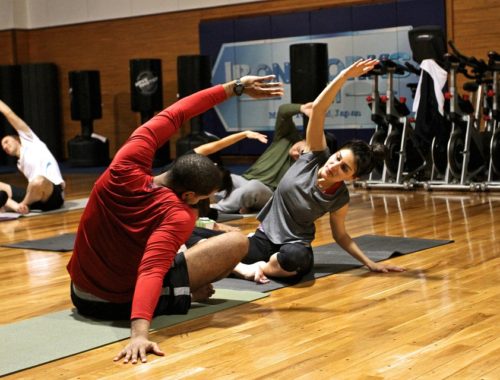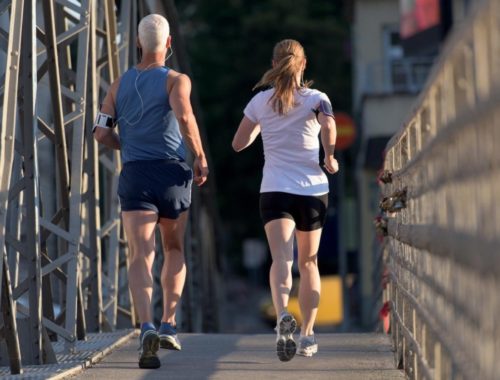Prevent
Getting Enough Exercise to Lower Cancer Risk

Are you meeting the daily recommended amount of exercise?
A recent study by the National Cancer Institute, published in JAMA Internal Medicine, shows that regular exercise reduces the risk of at least 13 types of cancer.
Meeting exercise goals that help lower your cancer risk can be easier than you think. Here are some facts on the cancer preventing benefits of exercise and some tips on fitting physical activity into your daily life.

Exercise May Reduce Cancer Risk More Than 20%
The findings on exercise came from the combined results of 12 large studies conducted in the United States and Europe.
The data tracked the lifestyles of more than 1.4 million people over the years 1987 to 2004. The studies specifically looked at “leisure-time” physical activities that people voluntarily chose to do in order to protect their health.
Analysis from all the studies showed that people who practiced higher levels of physical activity had lower risk for 13 of the 26 cancers examined.
This included risk reductions of 20% or more for seven cancers:
- Esophageal adenocarcinoma
- Liver
- Lung
- Kidney
- Gastric cardia
- Endometrium
- Myeloid leukemia
Slightly lower risk reduction (10–20%) was also found for the following cancers:
- Myeloma
- Colon cancer
- Head and neck cancer
- Rectal cancer
- Bladder cancer
- Breast cancer
How Much is Enough Exercise?
Despite the already well-known health benefits of exercise, the study also found inactivity is still quite common. About 51% of people in the United States and 31% of people worldwide are not meeting the recommended levels of physical activity.
US Department of Health and Human Services physical activity guidelines suggest adults get at least:
- 2.5 hours a week of moderate-intensity, or
- 1 hour and 15 minutes a week of vigorous-intensity aerobic
But meeting these goals doesn’t have to mean getting a gym membership.
“Moderate intensity” activities are those you can do while talking without stopping to catch your breath. These activities take about as much effort as a brisk walk. Even daily tasks can count toward meeting moderate activity goals. Some of examples include:
- Biking on flat terrain
- Gardening (raking, trimming shrubs, mowing the lawn)
- Household chores (washing windows, vacuuming, mopping)
- Dancing
- Easy jogging or swimming

“Vigorous intensity” activities are the ones that traditionally come to mind when thinking about exercise. These are activities you can only say a few words during without stopping to catch your breath. Examples include:
- Sports with a lot of running (basketball, soccer)
- Swimming laps
- Jumping rope
- Hiking uphill
- Carrying heavy loads
To get the full health benefits, activities should be done for at least 10 minutes at a time and spread throughout the week.
The Cancer Benefits of Exercise
More research is still needed to find the exact source of the cancer benefits of exercise. The authors of the exercise study note that other factors like diet and smoking may also play a role in the results.
But there are several ways exercise affects the body that might influence cancer prevention.
Getting regular physical exercise can:
- Lower hormones levels linked to cancer development, like insulin and estrogen
- Keep you at a healthy weight to avoid the cancer risks associated with obesity
- Reduce inflammation
- Allow food to pass through your body more quickly, reducing your digestive tract’s exposure to cancer-causing substances

Wear Sunscreen When Exercising Outdoors
The study found that the risk for two cancers actually increased with more exercise: non-advanced prostate cancer and malignant melanoma.
According to the authors, “screening bias” likely affected the higher rate for prostate cancer. This means that active men are more likely to get health exams and be diagnosed with this cancer, than those who avoid regular check ups.
However, the increase of malignant melanoma (an aggressive form of skin cancer) likely comes from time spent exercising outdoors. The best way to avoid this potential risk is to always practice safe sun habits, including wearing sunscreen.
See our article on best sunscreen practices for more details on skin cancer and safety tips.

Exercise is an Essential Part of a Healthy Lifestyle
Exercising is one of the best lifestyle choices you can make, regardless of the state of your health.
Even after being diagnosed with cancer, getting just 30 minutes of exercise has been found to increase survival rates by 40%. Aside from improving cancer prevention and survival, physical activity can reduce the stress of going through cancer treatment. Exercise can benefit your quality of life by relieving fatigue, nausea, and emotional distress.
Find an activity you enjoy, whether it’s a dancing class, a stroll through a park, or starting a garden to help make exercise a welcomed part of your life.





